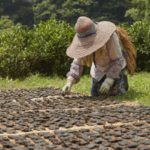【47 Hakko Tokushima】徳島の阿波晩茶 Awabancha 〜爽やかな酸味で染みわたる、山の発酵茶〜
爽やかな酸味で染みわたる、山の発酵茶
四国には地元の人しか知られていない発酵茶がある。徳島の山間地、上勝の阿波晩茶もそのひとつ。茶葉をアナログな道具で擦って、樽に仕込んで乳酸発酵させる。日本酒の山卸し(米をすり潰して野生の乳酸菌を呼び込む)と似た原理だ。高知の碁石茶ではカビの力を使って茶葉の細胞を破壊するが、阿波晩茶の場合は物理的な力を使って破壊する。発酵茶といっても熟成感より爽やかな酸味のインパクトが強い、清涼感すら感じるローカル茶だ。
A fermented mountain tea permeated by a refreshing sour taste
There are several fermented teas known to few outside of the locals of Shikoku. One of those is the awabancha of Kamikatsu, in the mountains of Tokushima. The tea leaves are brushed with analog tools, then treated through a lactic fermentation process in a barrel. The process is similar to the yama-oroshi process (in which rice is mashed in order to bring forth the wild lactic acid bacteria) through which sake is made. While in the process of making the goishicha of Kochi, the leaves are broken down through the force of the bacteria, in the case of awabancha the leaves are broken down through physical force. Though it is a fermented tea, it has less a heavily matured feel, and more a refreshing, sour impact. It is an invigorating, local tea.
どう作って食べるか / HOW TO MAKE & EAT
❶収穫した茶葉を茹で、茶擦り機でよく揉捻する。
❷樽に茶葉を仕込み、重しをして2〜3週間ほど乳酸発酵する。
❸樽からあげて乾燥させる。
❶Steam the freshly harvested tea leaves, then put them through a tea-leaf grinder.
❷Pack the tea leaves into a barrel, weigh them down, then allow them to go through lactic fermentation for 2-3 weeks.
❸Take the leaves out of the barrel and dry them.
お茶として
As a tea
▶食べられている地域 / Regions where it is eaten
徳島県
Tokushima Prefecture
▶微生物の種類 / Types of microorganisms
乳酸菌類、その他細菌類など
Lactic acid bacteria and various other types of bacteria

